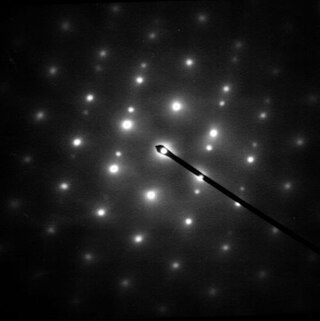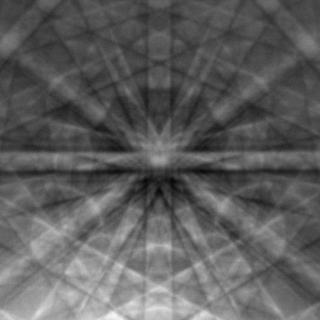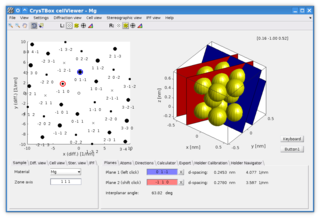Related Research Articles

Electron diffraction is a general term for phenomena associated with changes in the direction of electron beams due to elastic interactions with atoms. Close to the atoms the changes are described as Fresnel diffraction; far away they are called Fraunhofer diffraction. The resulting map of the directions of the electrons far from the sample is called a diffraction pattern, see for instance Figure 1. These patterns are similar to x-ray and neutron diffraction patterns, and are used to study the atomic structure of gases, liquids, surfaces and bulk solids. Electron diffraction also plays a major role in the contrast of images in electron microscopes.

Sir Nevill Francis Mott was a British physicist who won the Nobel Prize for Physics in 1977 for his work on the electronic structure of magnetic and disordered systems, especially amorphous semiconductors. The award was shared with Philip W. Anderson and J. H. Van Vleck. The three had conducted loosely related research. Mott and Anderson clarified the reasons why magnetic or amorphous materials can sometimes be metallic and sometimes insulating.

Sir Aaron Klug was a British biophysicist and chemist. He was a winner of the 1982 Nobel Prize in Chemistry for his development of crystallographic electron microscopy and his structural elucidation of biologically important nucleic acid-protein complexes.

Electron backscatter diffraction (EBSD) is a scanning electron microscopy (SEM) technique used to study the crystallographic structure of materials. EBSD is carried out in a scanning electron microscope equipped with an EBSD detector comprising at least a phosphorescent screen, a compact lens and a low-light camera. In this configuration, the SEM incident beam hits the tilted sample. As backscattered electrons leave the sample, they interact with the crystal's periodic atomic lattice planes and diffract according to Bragg's law at various scattering angles before reaching the phosphor screen forming Kikuchi patterns (EBSPs). EBSD spatial resolution depends on many factors, including the nature of the material under study and the sample preparation. Thus, EBSPs can be indexed to provide information about the material's grain structure, grain orientation, and phase at the micro-scale. EBSD is applied for impurities and defect studies, plastic deformation, and statistical analysis for average misorientation, grain size, and crystallographic texture. EBSD can also be combined with energy-dispersive X-ray spectroscopy (EDS), cathodoluminescence (CL), and wavelength-dispersive X-ray spectroscopy (WDS) for advanced phase identification and materials discovery.
Electron crystallography is a method to determine the arrangement of atoms in solids using a transmission electron microscope (TEM). It can involve the use of high-resolution transmission electron microscopy images, electron diffraction patterns including convergent-beam electron diffraction or combinations of these. It has been successful in determining some bulk structures, and also surface structures. Two related methods are low-energy electron diffraction which has solved the structure of many surfaces, and reflection high-energy electron diffraction which is used to monitor surfaces often during growth.

A scanning transmission electron microscope (STEM) is a type of transmission electron microscope (TEM). Pronunciation is [stɛm] or [ɛsti:i:ɛm]. As with a conventional transmission electron microscope (CTEM), images are formed by electrons passing through a sufficiently thin specimen. However, unlike CTEM, in STEM the electron beam is focused to a fine spot which is then scanned over the sample in a raster illumination system constructed so that the sample is illuminated at each point with the beam parallel to the optical axis. The rastering of the beam across the sample makes STEM suitable for analytical techniques such as Z-contrast annular dark-field imaging, and spectroscopic mapping by energy dispersive X-ray (EDX) spectroscopy, or electron energy loss spectroscopy (EELS). These signals can be obtained simultaneously, allowing direct correlation of images and spectroscopic data.
Sir Peter Bernhard Hirsch HonFRMS FRS is a British metallurgist who has made fundamental contributions to the application of transmission electron microscopy to metals.

Selected area (electron) diffraction is a crystallographic experimental technique typically performed using a transmission electron microscope (TEM). It is a specific case of electron diffraction used primarily in material science and solid state physics as one of the most common experimental techniques. Especially with appropriate analytical software, SAD patterns (SADP) can be used to determine crystal orientation, measure lattice constants or examine its defects.

David John Hugh Cockayne FRS FInstP was Professor in the physical examination of materials in the Department of Materials at the University of Oxford and professorial fellow at Linacre College from 2000 to 2009. He was the president of the International Federation of Societies for Microscopy from 2003 till 2007, then vice-president 2007 to 2010.

Richard Henderson is a British molecular biologist and biophysicist and pioneer in the field of electron microscopy of biological molecules. Henderson shared the Nobel Prize in Chemistry in 2017 with Jacques Dubochet and Joachim Frank.„Thanks to his work, we can look at individual atoms of living nature, thanks to cryo-electron microscopes we can see details without destroying samples, and for this he won the Nobel Prize in Chemistry."

Ernst G. Bauer is a German-American physicist known for his studies in the field of surface science, thin film growth and nucleation mechanisms and the invention in 1962 of the Low Energy Electron Microscopy (LEEM). In the early 1990s, he extended the LEEM technique in two directions by developing Spin-Polarized Low Energy Electron Microscopy (SPLEEM) and Spectroscopic Photo Emission and Low Energy Electron Microscopy (SPELEEM). He is currently Distinguished Research Professor Emeritus at the Arizona State University.
Michael John Whelan HonFRMS FRS FInstP is a British scientist.

Sir Colin John Humphreys, is a British physicist. He is the Professor of Materials Science at Queen Mary University of London.
Knut W. Urban is a German physicist. He has been the Director of the Institute of Microstructure Research at Forschungszentrum Jülich from 1987 to 2010.
The Fernand Holweck Medal and Prize is a major European prize for Physics awarded jointly every year by the British Institute of Physics (IOP) and the Société Française de Physique (SFP). It is one of the four Grand Prix of the SFP and one of the four International Bilateral Awards of the IOP, consisting of a gold medal and a 3000€ cash prize.

Paul Anthony Midgley FRS is a Professor of Materials Science in the Department of Materials Science and Metallurgy at the University of Cambridge and a fellow of Peterhouse, Cambridge.
Li Fanghua was a Hong Kong-born Chinese physicist. She was a member of the Chinese Academy of Sciences, The World Academy of Sciences, and the International Union of Crystallography. She was also the director of Chinese Society of Physics and China Union of Crystallography, and an editor of the Journal of Chinese Electron Microscopy Society, J. Electron Microscopy, Chinese Physics Letter, and Chinese Journal of Physics.
Carol Trager-Cowan is a Scottish physicist who is a Reader in physics and Science Communicator at the University of Strathclyde. She works on scanning electron microscopy, including Electron backscatter diffraction (EBSD), diffraction contrast and cathodoluminescence imaging.

Convergent beam electron diffraction (CBED) is an electron diffraction technique where a convergent or divergent beam of electrons is used to study materials.

CrysTBox is a suite of computer tools designed to accelerate material research based on transmission electron microscope images via highly accurate automated analysis and interactive visualization. Relying on artificial intelligence and computer vision, CrysTBox makes routine crystallographic analyses simpler, faster and more accurate compared to human evaluators. The high level of automation together with sub-pixel precision and interactive visualization makes the quantitative crystallographic analysis accessible even for non-crystallographers allowing for an interdisciplinary research. Simultaneously, experienced material scientists can take advantage of advanced functionalities for comprehensive analyses.
References
- 1 2 3 4 5 Colliex, Christian (1996). "John Wickham Steeds, Holweck Prize 1996". Microscopy Microanalysis Microstructures. EDP Sciences. 7 (4): V. doi: 10.1051/mmm:01996007040r500 . ISSN 1154-2799.
- 1 2 3 4 5 "John Steeds". London: Royal Society. Archived from the original on 2015-11-23. Retrieved 2017-07-13. One or more of the preceding sentences may incorporate text from the royalsociety.org website where "all text published under the heading 'Biography' on Fellow profile pages is available under Creative Commons Attribution 4.0 International License" (Royal Society Terms, conditions and policies, Intellectual property rights).
- ↑ "Professor John Steeds - Physics". www.bristol.ac.uk. 2017-02-20. Archived from the original on 2017-08-06. Retrieved 2017-07-13.
- ↑ "EC/1988/37: Steeds, John Wickham". The Royal Society . Retrieved 13 July 2017.
- ↑ Physics, Institute of. "Holweck medal recipients". Institute of Physics - For physics • For physicists • For all. Retrieved 2017-07-13.